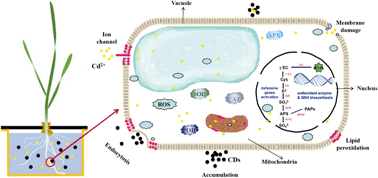Carbon dots alleviate the toxicity of cadmium ions (Cd2+) toward wheat seedlings†
Abstract
Heavy metal pollution poses great toxicity to plants, which makes methods to mitigate the heavy metal-induced toxicity desirable. This study explored the efficacy of carbon dots (CDs) in reducing the toxicity of cadmium ions (Cd2+) to wheat seedlings after 5 days of hydroponic exposure. When treated with Cd2+, the addition of CDs (50 and 75 mg L−1) can significantly reduce the cadmium content (33.1–57.7%) in the roots and leaves. Adsorption experiments proved that CDs could adsorb Cd2+. The physiological results showed that Cd2+ at 50 mg L−1 reduced the shoot length (32.4 ± 5.2%) of wheat, increased the content of soluble sugar and soluble protein, and increased APX, CAT and POD activity in wheat leaves. Comparatively, the joint treatment of 50 mg L−1 Cd2+ and 50 mg L−1 CDs significantly recovered the above parameters. Regarding the synthesis of glutathione (an antioxidant), 50 mg L−1 Cd2+ decreased the expression of related genes (ATPS) by 36.9 ± 4.4% and indirectly enhanced the expression of APR, SiR, CS and GS. In contrast, in the treatment with both Cd2+ and CDs (50 and 75 mg L−1), the expression of ATPS was higher and the expressions of APR and SiR genes were lower than those in the group of 50 mg L−1 Cd2+ alone. This finding confirms that CDs can alleviate the abiotic stress induced by Cd2+ to plants and lays the foundation for its application in environmental protection and agricultural production.



 Please wait while we load your content...
Please wait while we load your content...